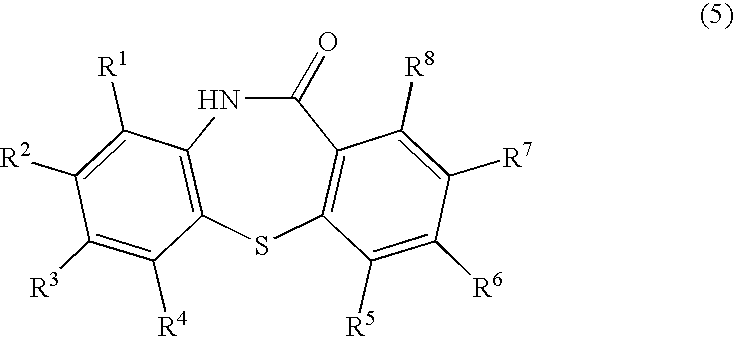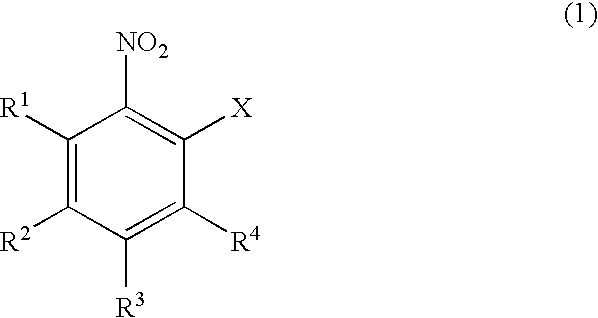Process for preparing dibenzothiazepine derivatives
a technology of dibenzothiazepine and dibenzothiazepine, which is applied in the field of process for preparing dibenzothiazepine derivatives, can solve the problems of high temperature reaction conditions, low yield, and inability to easily obtain starting compounds, and achieve easy to obtain materials. good yield
- Summary
- Abstract
- Description
- Claims
- Application Information
AI Technical Summary
Benefits of technology
Problems solved by technology
Method used
Image
Examples
example 1
[0088] In 120 mL of N,N-dimethylformamide were dissolved 94.5 g (0.60 mol.) of 2-chloronitrobenzene and 159.0 g (1.15 mol.) of potassium carbonate. To the resulting N,N-dimethylformamide solution was dropwise added a solution of 77.1 g (0.50 mol.) of thiosalicylic acid in 120 mL of N,N-dimethylformamide. The resulting mixture was then stirred at 70° C. for 6 hours, for carrying out the reaction. To the reaction mixture were added 800 mL of water and 700 mL of ethyl acetate. The aqueous portion was separated and made acidic by addition of 400 g of ice and 194 mL of conc. hydrochloric acid. The acidic solution was stirred at room temperature for one hour. The precipitated crystalline product was collected by filtration and dried to obtain 134.0 g (0.49 mol.) of 2-nitro-2′-carboxy-diphenylsulfide as a yellow powder. The yield from thiosalicylic acid was 98%.
[0089]1H-NMR (DMSO-d6): δ 7.1-8.3 (m, 8H), 13.1-13.5 (br., 1H)
example 2
[0090] In 120 mL of N,N-dimethylformamide were dissolved 94.5 g (0.60 mol.) of 2-chloronitrobenzene and 159.0 g (1.15 mol.) of potassium carbonate. To the resulting N,N-dimethylformamide solution was dropwise added a solution of 77.1 g (0.50 mol.) of thiosalicylic acid in 120 mL of N,N-dimethylformamide. The resulting mixture was then stirred at 70° C. for 6 hours, for carrying out the reaction. The aqueous portion was separated and made acidic by addition of 200 mL of water and 194 mL of conc. hydrochloric acid. The acidic solution was stirred at room temperature for one hour. The precipitated crystalline product was collected by filtration and dried to obtain 123.0 g (0.45 mol.) of 2-nitro-2′-carboxy-diphenylsulfide as a yellow powder. The yield from thiosalicylic acid was 90%.
example 3
[0091] The procedures of Example 1 were repeated except for employing 121.2 g (0.60 mol.) of 2-bromonitrobenzene in place of 2-chloronitrobenzene, to obtain 134.0 g (0.49 mol.) of 2-nitro-2′-carboxy-diphenylsulfide. The yield from thiosalicylic acid was 98%.
PUM
| Property | Measurement | Unit |
|---|---|---|
| temperature | aaaaa | aaaaa |
| boiling temperature | aaaaa | aaaaa |
| atmospheric pressure | aaaaa | aaaaa |
Abstract
Description
Claims
Application Information
 Login to View More
Login to View More - R&D
- Intellectual Property
- Life Sciences
- Materials
- Tech Scout
- Unparalleled Data Quality
- Higher Quality Content
- 60% Fewer Hallucinations
Browse by: Latest US Patents, China's latest patents, Technical Efficacy Thesaurus, Application Domain, Technology Topic, Popular Technical Reports.
© 2025 PatSnap. All rights reserved.Legal|Privacy policy|Modern Slavery Act Transparency Statement|Sitemap|About US| Contact US: help@patsnap.com



